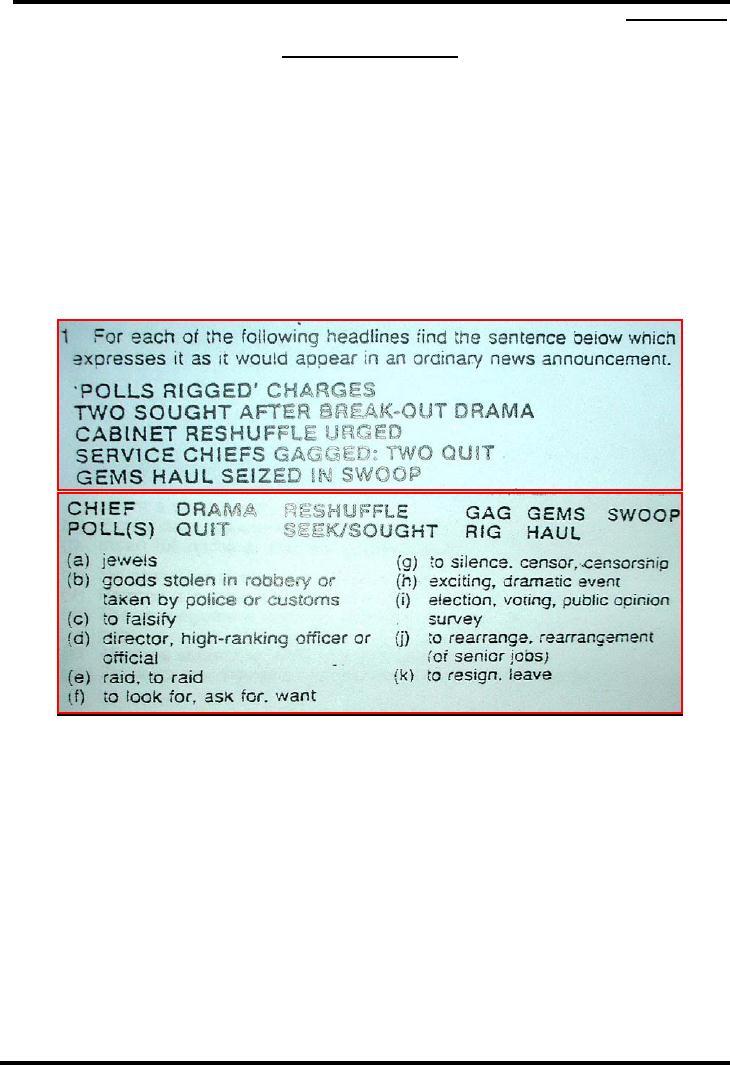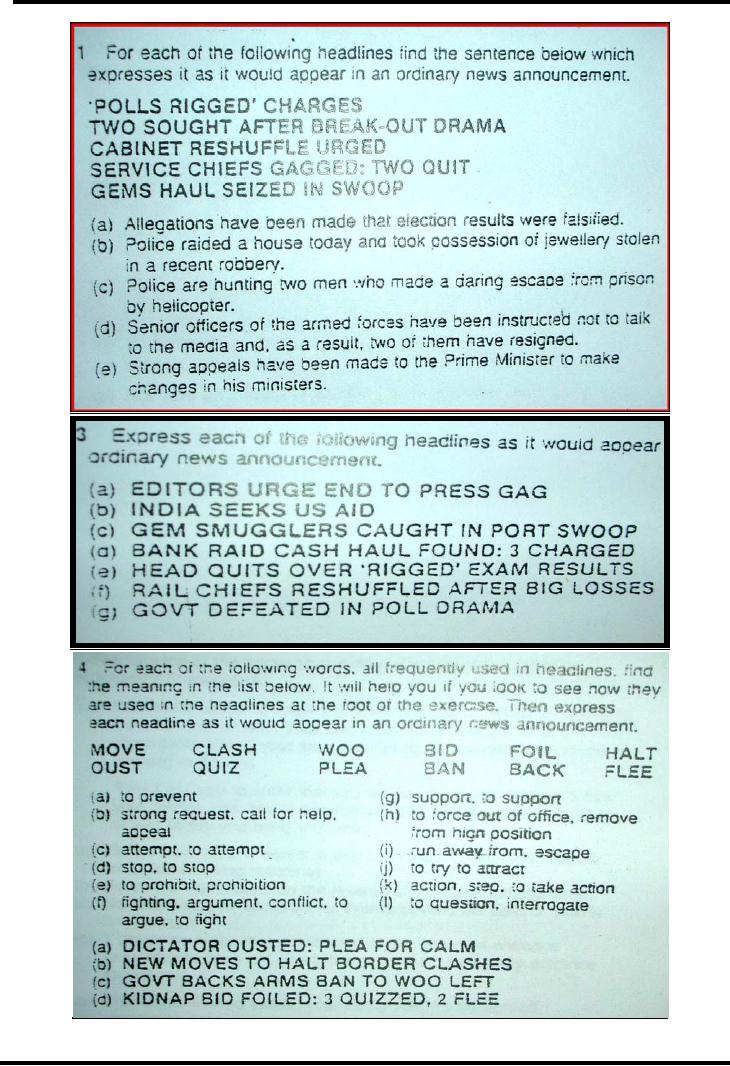 |
News Writing and Style I:WHAT TO LOOK FOR IN A NEWSPAPER |
| << THE LANGUAGE OF THE NEWSPAPERS II:BROADSHEET NEWSPAPER |
| NEWS WRITING II:Accuracy, Clarity, Style, Qualities of Effective Leads >> |

Journalistic
Writing MCM310
VU
LECTURE
34
News
Writing and Style I
WHAT
TO LOOK FOR IN A
NEWSPAPER
1.
Register:
2.
Lexis:
3.
Grammar
4.
Metaphorical language:
5.
Sources:
6.
Typographical features:
Newspaper
Style: Practice
130

Journalistic
Writing MCM310
VU
131

Journalistic
Writing MCM310
VU
Still,
news professionals agree on at
least seven main factors
that help them determine if an event is
news.
These
are:
a)
Impact--how many people does the event
affect? How seriously does
it affect them?
b)
Proximity--an event will be more
important if is closer to the readers. An
earthquake in a far-off land is
not
as
interesting
as
one
that
is
close
to
home.
c)
Timeliness--is the event fresh? Is it
new? The news must be
timely to be of use to
readers.
d)
Prominence--Names make news,
and big names make
big news. Ordinary people
are intrigued by the
doings
of
the
rich
and
famous.
e)
Novelty--this is the new in news, the
unusual. The "firsts," "lasts"
and "only" have been the
staples of the
news
business
for
many
years.
f)
Conflict-- Conflict has been
the currency of great literature, drama
and movies for all time.
From the stories
of
Shakespeare to those of Disney, conflict
has played a crucial role.
Newspapers are no
different.
g)
Audience--who is the audience? The
answer to that question helps
determine whether an event is news
at
all,
and if it is, where it will
be played in the paper.
The
ABC of news writing:
�
Accuracy
�
Brevity:
�
No
wordy expressions.
�
Include
only relevant statements.
�
Avoid
Unnecessary Repetition
�
Clarity:
�
Choose
short, familiar but standard
words.
�
Construct
effective sentences and
paragraphs
�
Achieve
appropriate readability
�
Include
sources both official and
unofficial to authenticate your
evidence, if possible.
"I
want stories to startle and
engage me within the first
few sentences, and in their
middle to widen or deepen
or
sharpen my knowledge of human activity,
and to end by giving me a
sensation of completed
statement."
-
John Updike
132
Table of Contents:
- INTRODUCTION TO JOURNALISTIC WRITING:Practical, THINGS TO KNOW
- QUALITIES OF GOOD WRITERS
- QUALITIES OF GOOD WRITERS
- QUALITIES OF GOOD WRITING:Achieve appropriate readability:
- QUALITIES OF GOOD WRITING:Be concise, Be creative, Be correct
- THE PROCESS OF WRITING:INVENTION, WHEN YOU START TO WRITE
- THE PROCESS OF WRITING II:ORGANIZING, DRAFTING, REVISING
- ALL ABOUT WORDS:HOW WORDS ARE FORMED?:SUFFIXES
- DICTIONARY-A WRITER’S LANGUAGE TOOL:KINDS OF INFORMATION
- PARTS OF SPEECH:Noun Gender, Noun Plurals, Countable Nouns
- BASIC CLAUSE PATTERNS
- ACTIVE AND PASSSIVE VOICE
- MODIFIERS AND SENTENCE TYPES:COMPOUND SENTENCES
- REPORTED SPEECH:Indirect Questions, Direct commands
- GRAMMATICAL SENTENCE – ISSUES:SUBJECT-VERB AGREEMENT
- GRAMMATICAL SENTENCE – ISSUES II:SENTENCE FRAGMENTS
- EFFECTIVE SENTENCE:PARALLELISM, NEEDED WORDS, SHIFTS
- STYLE: GUIDELINE AND PITFALLS I:COLLOQUIAL VS FORMAL, CIRCUMLOCUTION
- STYLE: GUIDELINE AND PITFALLS II:AMBIGUITY, REDUNDANCY, EUPHEMISM:
- PARAGRAPH WRITING: TYPES AND TECHNIQUES:STRUCTURE
- PARAGRAPH WRITING: TYPES AND TECHNIQUES:Putting on Our Play
- ESSAY WRITING:VARIOUS STRATEGIES FOR ESSAYS, PROMPTS
- SIGNAL WORDS:Non word Emphasis Signals
- EXPOSITORY WRITING:LOGICAL FALLACIES, APPEAL TO EMOTION
- THE WRITING STYLES: REPORT and NARRATIVE WRITING, SHORT REPORTS
- THE WRITING STYLES: DESCRIPTIVE AND PERSUASIVE WRITINGS, Observation
- RESEARCH WRITING AND DOCUMNETING SOURCES:Handling Long Quotations
- Summary and Précis Writing:CHARACTERISTICS OF GOOD SUMMARY
- Punctuation:THE PERIOD, THE COMMA, THE SEMICOLON, THE COLON
- MECHANICS:ABBREVIATIONS, NUMBERS, SPELLING, THE HYPHEN
- READING SKILLS FOR WRITERS:EDUCATED READING, STEPS
- PARTS OF A NEWSPAPER:Box-out, By-line, Caption, Exclusive, Feature
- THE LANGUAGE OF THE NEWSPAPERS II:BROADSHEET NEWSPAPER
- News Writing and Style I:WHAT TO LOOK FOR IN A NEWSPAPER
- NEWS WRITING II:Accuracy, Clarity, Style, Qualities of Effective Leads
- EDITORIAL WRITING:WRITING AN EDITORIAL:STRUCTURING AN EDITORIAL
- WRITING FEATURES:GENERATING FEATURE STORY IDEAS
- WRITING COLUMNS:Column and a news report, Purpose, Audience
- WRITING ARTICLES FOR NEWSPAPERS:The Heading, The Lead
- WRITING ANALYSIS:purpose, scope, method, results, recommendations
- LETTERS TO EDITORS:Four important aspects about letters, Organizing letters
- BROADCAST AND WEB NEWS WRITING:WRITE CONCISELY, BROADCAST STYLE
- WRITING PRESS RELEASE, REVIEWS AND OBITUARIES:Summary of Content:
- THE ART OF INTERVIEWINGS
- FINAL THOUGHTS:Practical, Job-Related, Social, Stimulating, Therapeutic